Sunday, April 19: After leaving the Terra Cotta Warriors, our small group splits up. Mari and the Israeli mother and daughter return to Xi’an, while Andrew and I continue on with our guide Chelsea to Huaqing Pool.
Much like the fascinating story behind the Terra Cotta Warriors, Huaqing Pool also has an intriguing history, one that involves a tragic love story between an emperor and his concubine, and later, an incident involving Chiang Kai-shek and the Chinese Communist Party.
Huaqing Pool, also known as the Huaqing Hot Springs, was built in 723 by Emperor Xuanzong of the Tang dynasty. The pool was part of the Huaqing Palace, which was heated by geothermal springs flowing from Li Mountain and other surrounding mountains. The mineral-rich water was considered to be medically beneficial and flowed at a temperature of 43C, or 110F, degrees. Huaqing Pool has two claims to fame: it was the site of Xuanzong’s legendary romance with his concubine Yang Guifei, and, later, it was the scene of the 1936 Xi’an Incident, in which Chiang Kai-shek was kidnapped by former warlord Zhang Xueliang and forced to participate in a United Front with the Chinese Communist Party to oppose the Japanese invasion of China (Wikipedia: Huaqing Pool).
The name Hua means brilliant, Chinese or flowery and qing means pure or clear. Huaqing Hot Springs has a 3,000 year history in which various palace complexes and the famous imperial bathing pools figured prominently. The original Tang Dynasty Palace, which sprawled over an area of more than 85,000 square meters, was larger than the present site. All structures were rebuilt in 1959 in the Tang architectural style. The Huaqing Pool is a National Cultural Relic and one of China’s Hundred Famous Gardens (China Highlights: Huaqing Hot Springs).
Li Palace was first built during the Western Zhou dynasty (1045 – 256 BC) at the foot of Li Mountain. In the Qin dynasty (221 – 206 BC), a stone pool was built and was given the name Li Mountain Hot Springs. The site was enlarged during the Han dynasty (206 BC – 220 AD), and was once again named Li Palace. During the Tang dynasty (618 – 907), Emperor Taizong ordered the palace enlarged.
Finally, Emperor Xuanzong, his successor, had a walled palace built around Li Mountain in the year of 747. It was then known as Huaqing Palace, or Huaqing Hot Spring, because of the hot spring there. Over the course of 41 years, the emperor visited the palace as many as 36 times (China Highlights: Huaqing Hot Springs).
Emperor Xuanzong spent his winters at Huaqing Hot Spring in the company of his favorite concubine Yang Guifei. He was over 60 years old when he fell for his son’s concubine, and she reciprocated. According to historical records, during the 10 years from 745 to 755, the emperor brought Yang, along with his high-ranking officials, to the Huaqing Palace in October, and only returned to his capital palace in the spring of each following year. During that period, all domestic and diplomatic affairs of state were handled at Huaqing Palace, which thus began to flourish as an important political center (China Travel Guide: Huaqing Hot Springs).
Yang, who was recognized as one of the most enchanting ladies in ancient China, was spoiled by the emperor. He was so enraptured by the beautiful lady, that he neglected state business. He built luxurious palaces in this area purely for their personal pleasure. General An Lushan became disgruntled by the emperor’s misbehavior, so he led a rebellion against the emperor. As the general and his troops approached the palace, the emperor and his retinue escaped into Sichuan. Along the way, the army mutinied and demanded Yang Guifei be executed. In despair, she hanged herself. (China Highlights: Huaqing Hot Springs and Lonely Planet China).
At night, the “Song of Unending Sorrow” is presented on a water stage at Huaqing Pool. The historical drama tells of the romance between Emperor Xuanzong and Yang Guifei. Originally, the “Song of Unending Sorrow” was a long narrative poem created by Bai Juyi (772 – 846), a famous realistic poet of the Tang Dynasty. Nowadays, the poem tells the love story in four parts: Falling in Love, The Inseparable Couple, Farewell to Lover and Reunification in Fairyland (Travel China Guide: The Song of Unending Sorrow).
Near the hot spring ruins, we find a statue of the infamous Yang Guifei, surrounded by the usual entourage of Chinese tourists taking photographs and selfies.
I’m unable to get a photo of Yang without any Chinese people in it, but this one is the best of the lot.
The Hot Spring Scenic Area boasts 4 hot springs originating from Shiquan Cave. The water is rich in mineral substances that are supposedly good for health, such as lime, sodium carbonate, silica, alum and sulphur. Water in the Huaqing Hot Spring is not only good for bathing but is considered to be good for arthritis and skin disease. In the bathing area, 100-plus bathing rooms were equipped and could host around 400 persons for bathing (China Tour: Huaqing Hot Spring).
The site of the Imperial Pool is the only one of its kind in China. The five remaining pools are the Star Pool, Lotus Pool, Haitang Pool, Shangshi Pool, Star Pool and Prince Pool. They are no longer in use, nor do they have water in them, but we can still see the shapes and read about them on placards.
Star Pool was built for Emperor Taizong in 644 AD. The walls of Star Pool were built to emulate mountains and rivers and thus create a magnificent view. It is said that the former Star Pool had no roof and nothing to cover its four sides (China Travel Guide: Huaqing Hot Springs). This bathing pool looks like the Big Dipper along with the Kuixing Star Pool to its south.
Lotus Flower Pool, also known as the Imperial Nine Dragon Bathing Palace, was built in 747 AD exclusively for Emperor Xuanzong of the Tang Dynasty. The pool was constructed of limestones in oblong shape with two terraces, magnificent in design and grand in scale.
Haitang Pool, also known as Crabapple Pool, or Lotus Bathing Pool, was built in 747 AD for Lady Yang, the emperor’s favorite concubine. Therefore, it was colloquially called “Concubine’s Pool.” The bathing pool was constructed of lime stones and appears like a crabapple flower in full bloom, small and exquisite.
The Shangshi Pool was designated for officials.
After exploring all the ruined pools, we walk through some pretty gardens on our way to Huanyuan Garden.
Huanyuan Garden is the former garden of the Huaqing palace. A guest house was built here in 1878, which served as a temporary residence for some very important visitors including the Qing Emperor Guangxu and Empress Dowager Cixi during their inspection tour to Xi’an in 1900. It also hosted Chiang Kai-shek when he came to scheme an anti-Communist offense which led to the Xi’an Incident of 1936.
The Xi’an incident was a bit complicated. As the Japanese advanced into China, Chiang Kai-shek was determined to pursue his policy of national unification, with the goal of eradicating the Communists. He went to Xi’an to oversee an extermination campaign. The area at that time was controlled by Marshal Zhang Xueliang and his Manchurian troops. The Manchurian troops had become unhappy with Chiang Kai-shek and his policies, exacerbated by the fact that the Japanese were at that time occupying Manchuria. In secret meetings with the Communists, Zhang became convinced of the Communists’ anti-Japanese sentiments and on the morning of December 12, 1936, they stormed Chiang Kai-shek’s compound at the foot of Li Mountain. Most of the household staff were captured, but Chiang Kai-shek managed to escape halfway up the mountain, having bolted at the sound of gunfire still in his pajamas and without his false teeth. Chiang Kai-shek had to pay a ransom but was unharmed. He was allowed to remain leader of China as long as he allied with the Communists against the Japanese (Lonely Planet China).
Finally, we make our way out of Huaqing Pool to the exit. We find this pool covered in a dragon motif, so common throughout China.
I find this friendly man sitting on a turtle’s back in the stele garden.
Our tour is over, but we have quite a long drive back to Xi’an, where I’ll go out to explore the Muslim Quarter and taste some of the legendary food that’s offered there. 🙂


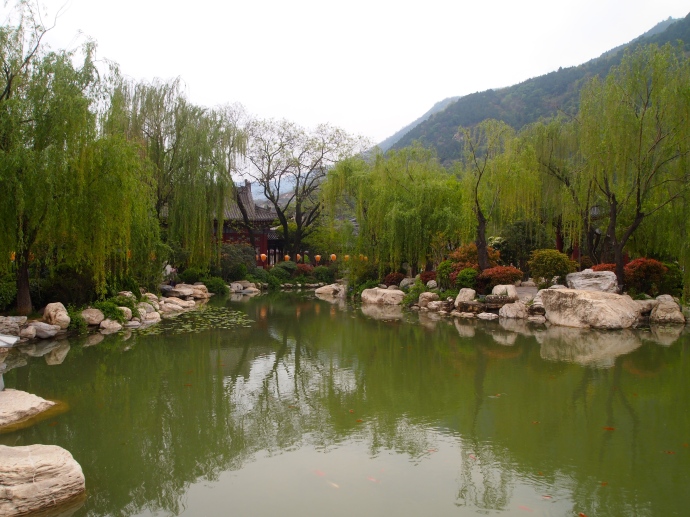
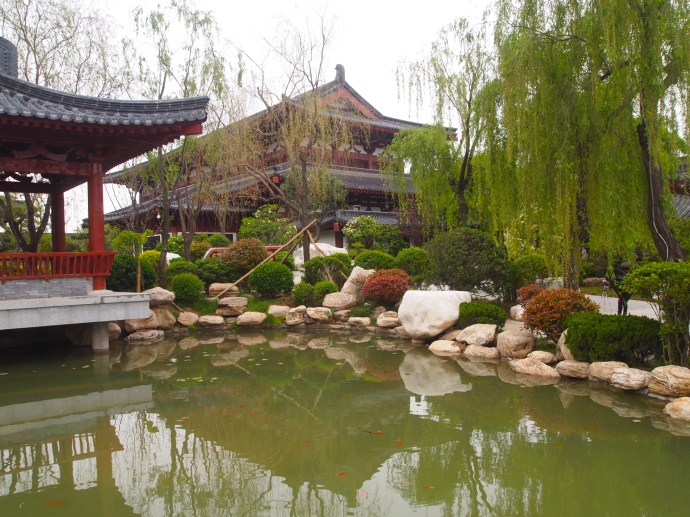
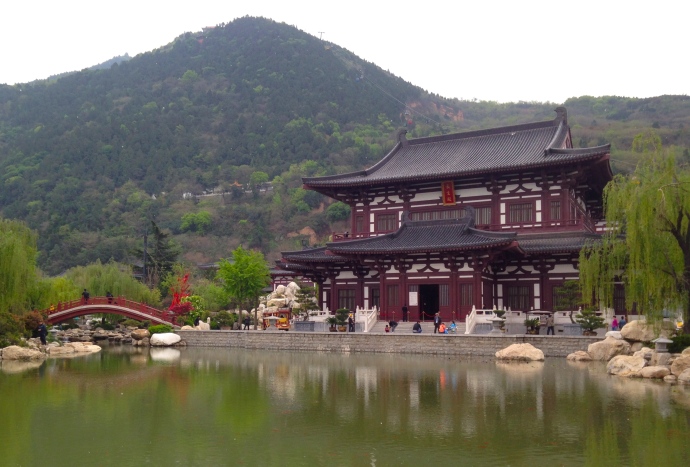





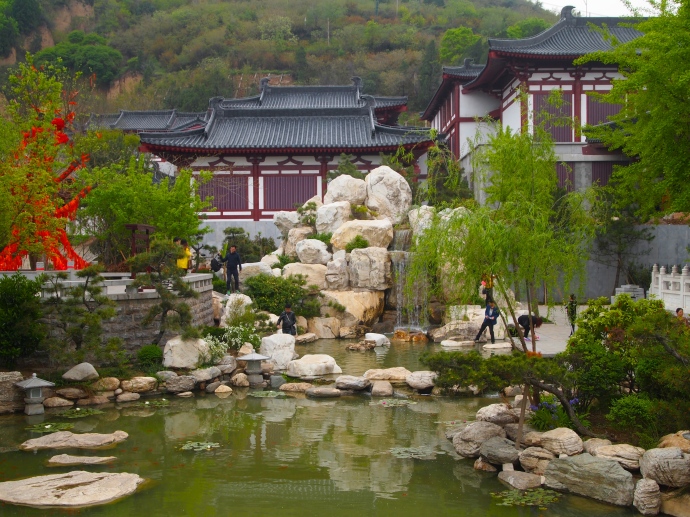
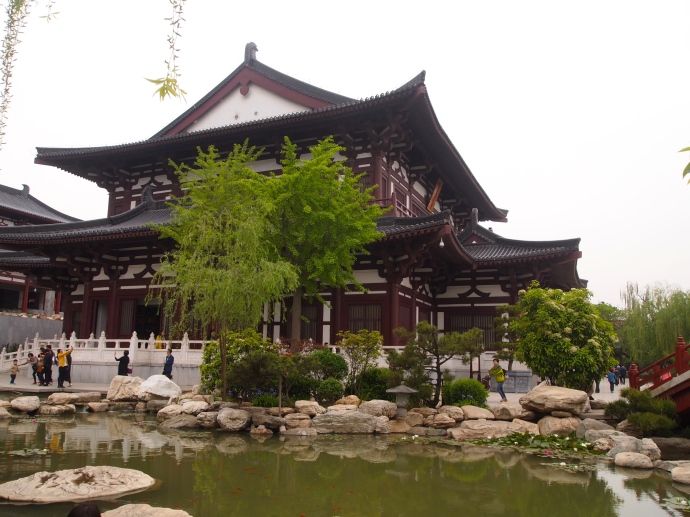

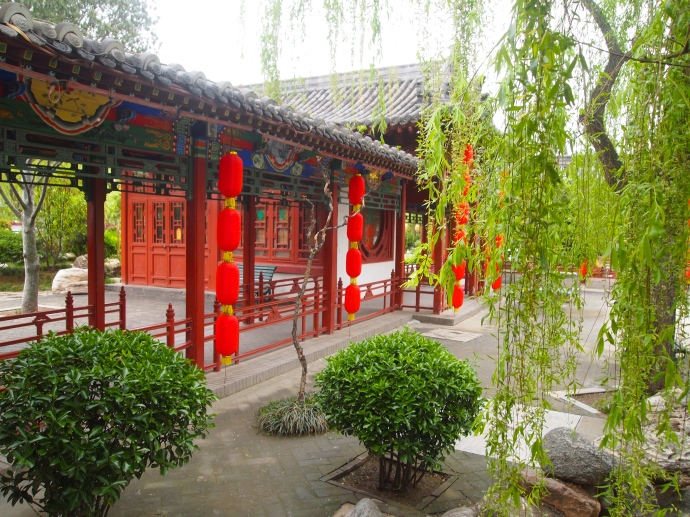
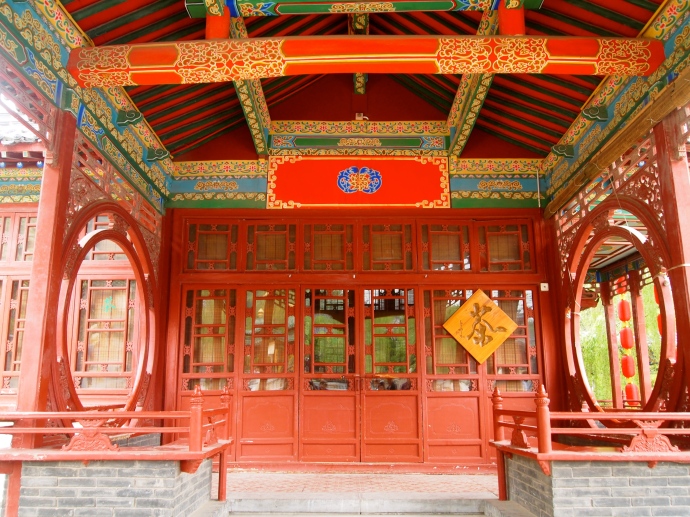





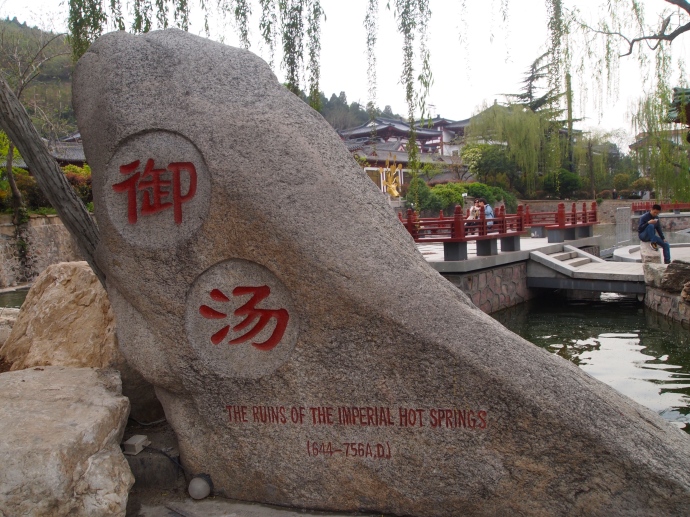
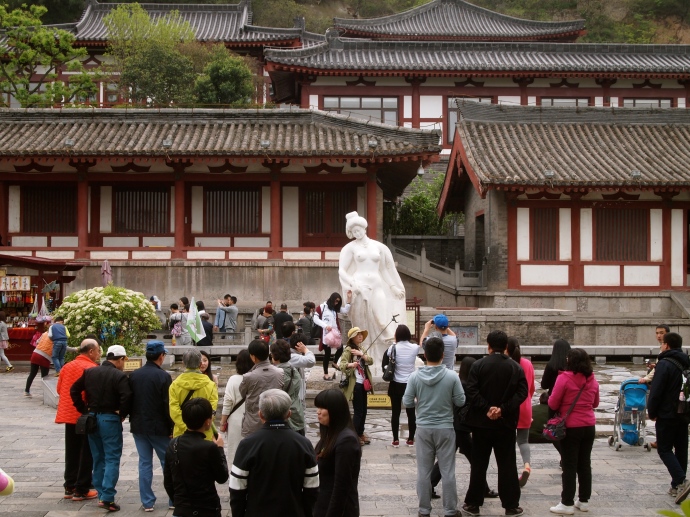
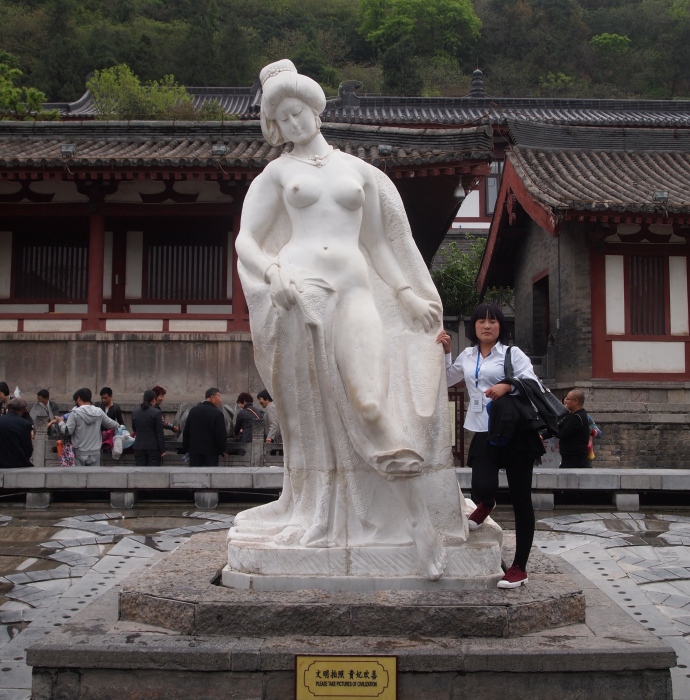
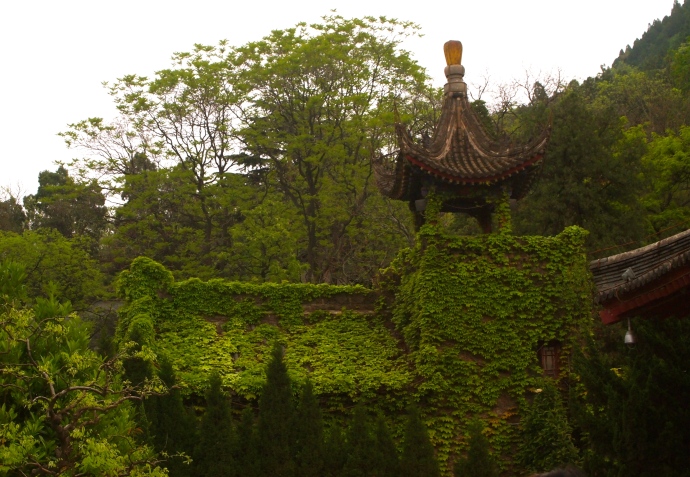
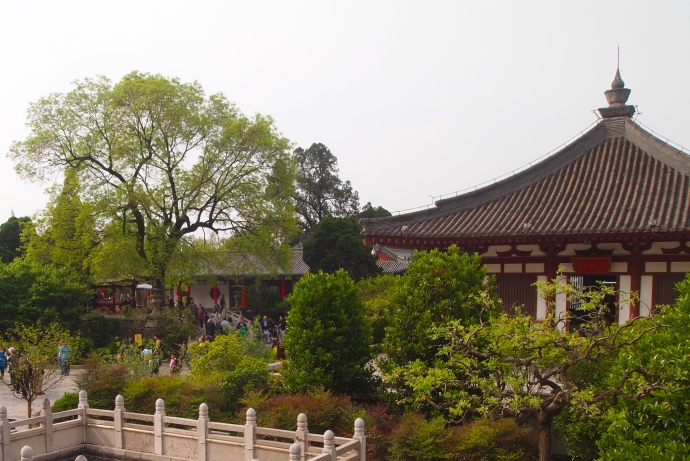





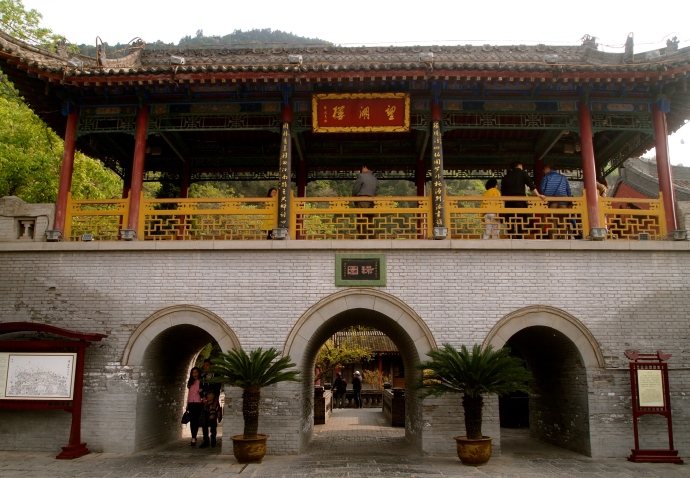
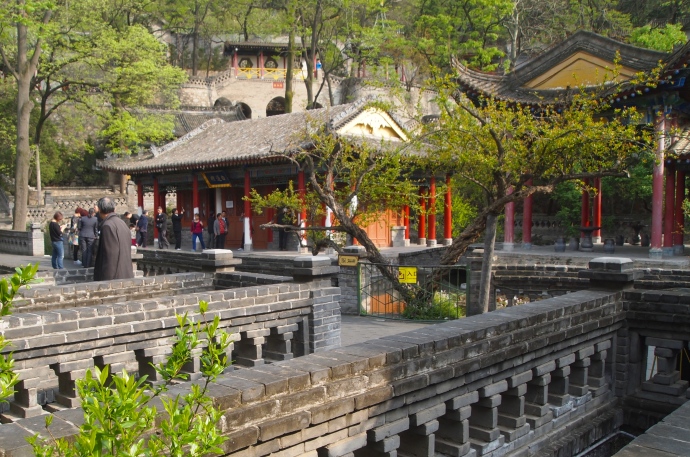
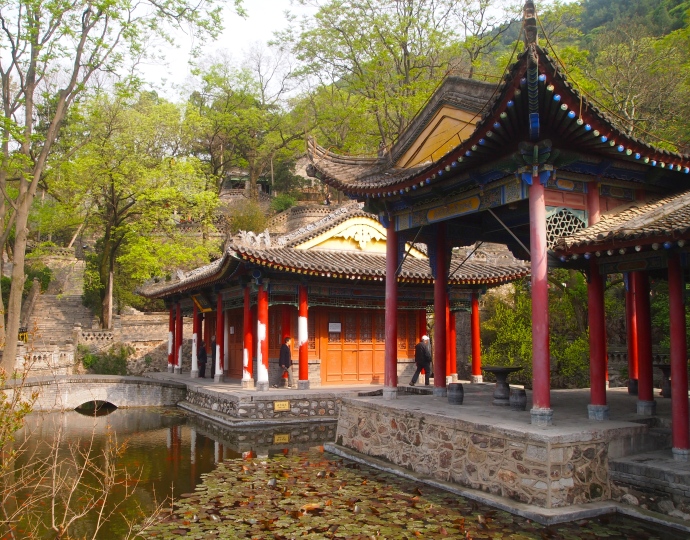
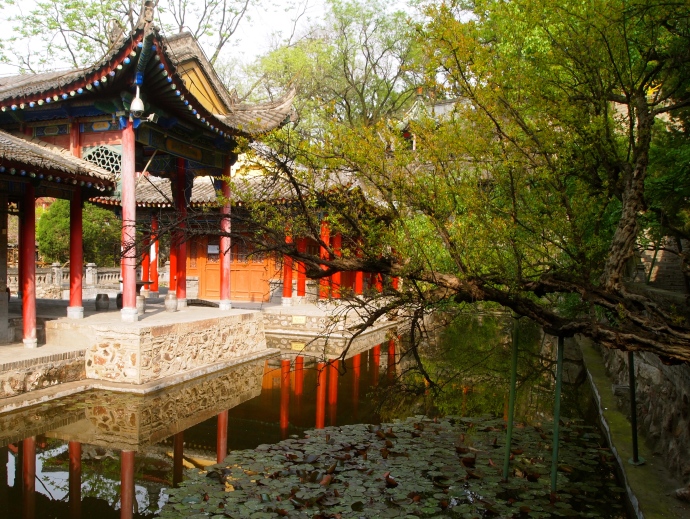







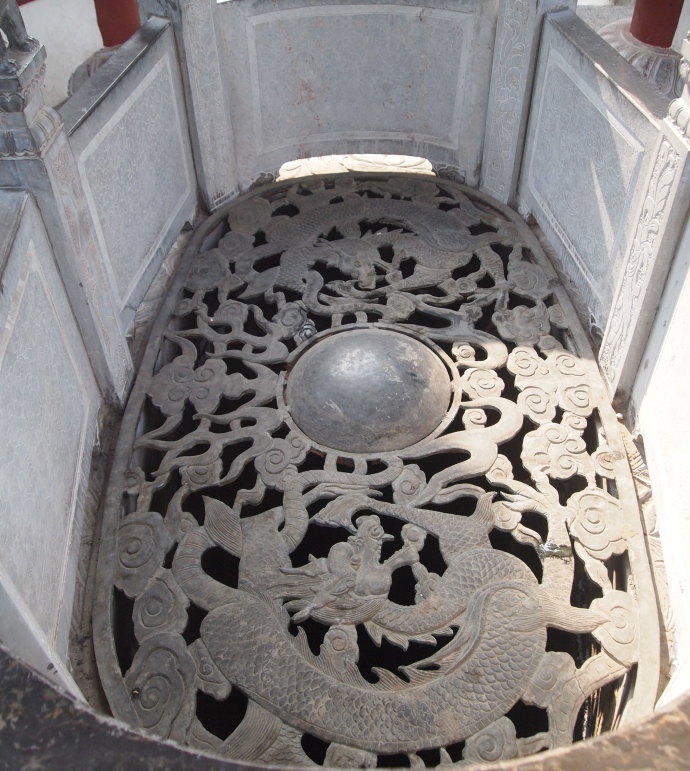

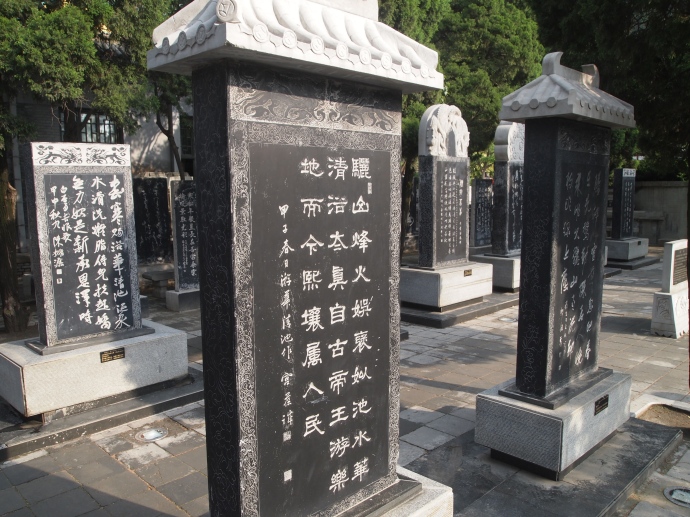
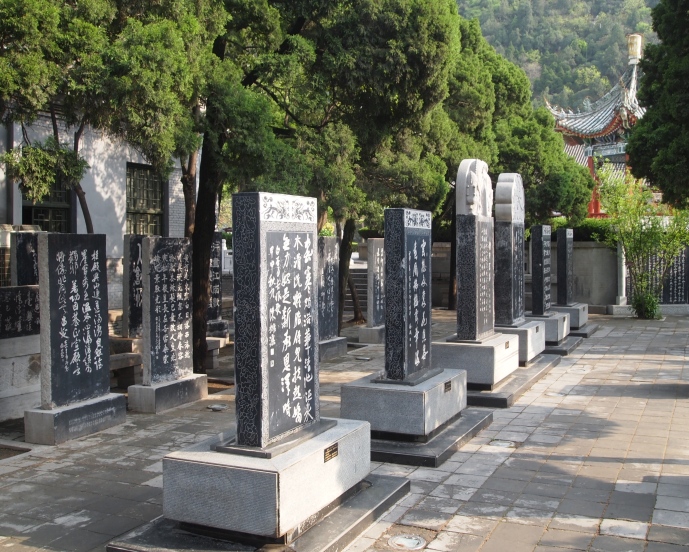
Such a tranquil-looking place. I suppose it could be annoying to always have people in your photos, but, on the other hand, it shows the true experience of traveling in China. 😉
LikeLike
I take it you’ve traveled to China, LaVagabonde! Yes, no picture taken in China is complete without Chinese people taking pictures or selfies! Thanks for dropping by and for commenting. 🙂
LikeLike
Haha. Nope. Haven’t been to China yet. But there are enough Asian tourists in Europe for me to understand. 😉
LikeLike
Yes, I’m sure you do. They often act the same wherever they go! 🙂
LikeLike
It looks like a pretty place, and the first few photos remind me of the pictures on Willow Pattern plates – I think it’s the weeping willow trees and little bridge that does it!
LikeLike
I’m not familiar with Willow Pattern plates, Elaine, but they must be pretty if they have weeping willows and little red bridges on them!! 🙂
LikeLike
So very beautiful, the wish tree and the water stage particularly – I wonder what is performed there!
LikeLike
Oh Gilly, I wrote in the post about the performance on that water stage. It’s the tragic love story of the emperor and his concubine, as written by an ancient Chinese poet. 🙂
LikeLike
So, I’m more of a visual person than I thought! Clearly treasure is missed when you skim through too quickly. I did look up Stele as I didn’t know the meaning, I suppose you’ll say that answer is in the post now !!! 🙂 Thanks Cathy.
LikeLiked by 1 person
I didn’t define “stele” in the post, Gilly, so you didn’t miss anything! 🙂
LikeLike
What a beautiful place. There’s something about it that feels/seems familiar to me, but I can’t put my finger on it just yet. I love the weeping willows, and the tree of wishes. Once again, the way the reds stand out is so amazing. Thank you, too, for the history lesson. China is an interesting country.
LikeLike
Thanks so much, Robin. Have you been to Beijing? Maybe it looks a bit like Houhai Lake or the Summer Palace. I love those weeping willows too. China certainly does have an interesting, and long, history. I love it when a place has a good story attached to it. 🙂
LikeLike
No, I haven’t been to China (or anywhere in Asia, for that matter). My world travels are not very extensive (England, Scotland, and various places in Canada). Maybe someday… 🙂
LikeLike
Maybe you’ve seen a garden somewhere in the US that was modeled after Chinese gardens then, Robin. Maybe someday you’ll travel more; I imagine if you want to, you will. I know many people content to travel in places where they feel comfortable! 🙂
LikeLike
What a great day out, Cathy. I thought the pool looked very dull in your first shots because of the flatness of the sky but then that bit of romance slips in and you had me hooked. She was a lovely looking lady if that sculpture’s anything to go by but your stand out shot is that lovely old guy who just gazes into the camera for you. Perfect portrait! (am I becoming obssessive with this subject? 🙂 🙂 )
Take care, Cathy. Counting down with you 🙂
LikeLike
It was a great day out, Jo! The pool did look very dull because of the dreary weather. I had two days of dreariness in Xi’an, but as we were at Huaqing Pool, the sun finally came out and stayed out through the next day. I love the stories of these historical places in China, especially the romantic ones. Thank you, Jo, for your compliment about the old guy. I took two pictures of him, signaling with my camera and asking permission to take his photo. In the first photo, his eyes were closed, but this one turned out perfectly. I was very happy with it. Thanks Jo, glad to know you’re counting down with me! 🙂
LikeLiked by 1 person